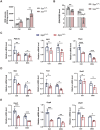Sulfide Quinone Oxidoreductase Alleviates Acute Ulcerative Colitis by Regulating Mitochondrial Dysfunction
- PMID: 40661137
- PMCID: PMC12256674
- DOI: 10.1002/mco2.70285
Sulfide Quinone Oxidoreductase Alleviates Acute Ulcerative Colitis by Regulating Mitochondrial Dysfunction
Abstract
Alteration in mitochondrial function within intestinal epithelial cells were closely related to inflammatory bowel disease (IBD) progression. Sulfide quinone oxidoreductase (SQOR), located in the inner mitochondria membrane, is a crucial enzyme in sulfide metabolism. Here, we observed that SQOR was downregulated during colitis. Intestinal epithelial cells specific knockout of SQOR (Sqor CKO) mice were more susceptible to acute ulcerative colitis (UC) with lower hydrogen sulfide (H2S) levels, and the absence of SQOR caused a breakdown of the epithelial barrier through disruption of the tight junction proteins. Furthermore, analysis of the mitochondrial morphology and functions revealed increased mitochondrial damage when SQOR deficiency. Mechanistically, it is observed that SQOR knockout increased lipid peroxidation, malondialdehyde (MDA) levels and ferroptosis. Further results demonstrated that SQOR may rely on inhibiting excessive mitochondrial division and promoting mitochondrial biogenesis to regulate reaction oxygen species (ROS) levels in intestinal epithelial cells. Treatment with ROS scavengers (NAC) showed significant reduced colonic inflammation symptoms observed in DSS-treated Sqor CKO mice. Collectively, these findings demonstrate the protective role of SQOR in intestinal epithelial cells in maintaining mitochondrial homeostasis by regulating ROS and providing novel insight into UC.
Keywords: ROS; intestinal epithelial cells; mitochondrial dynamics; sulfide quinone oxidoreductase; ulcerative colitis.
© 2025 The Author(s). MedComm published by Sichuan International Medical Exchange & Promotion Association (SCIMEA) and John Wiley & Sons Australia, Ltd.
Conflict of interest statement
The authors declare no conflicts of interest.
Figures








References
-
- Ordás I., Eckmann L., Talamini M., Baumgart D. C., and Sandborn W. J., “Ulcerative Colitis,” Lancet 380, no. 9853 (2012): 1606–1619. - PubMed
-
- Shmuel‐Galia L., Humphries F., Vierbuchen T., et al., “The lncRNA HOXA11os Regulates Mitochondrial Function in Myeloid Cells to Maintain Intestinal Homeostasis,” Cell Metabolism 35, no. 8 (2023): 1441–1456. e9. - PubMed
LinkOut - more resources
Full Text Sources
